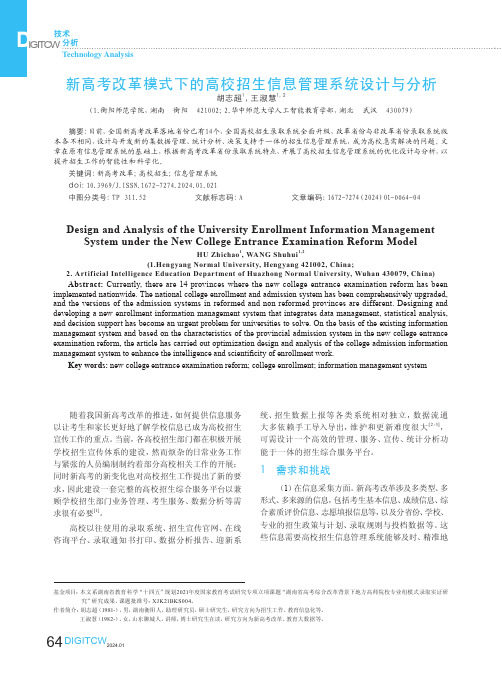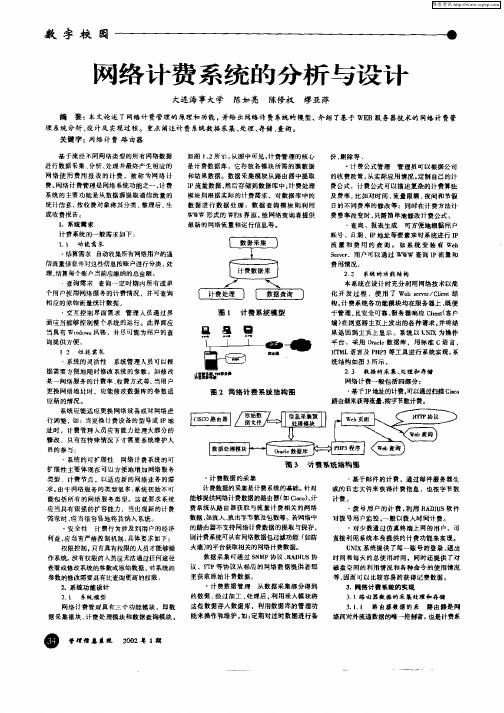系统分析与设计计
教学管理信息系统分析与设计案例

图 10-2 总体业务流程图分析
10.2.4 管理功能分析
按功能划分可将系统划分为教师管理、学生管理、用户管理、课程管理、成绩管理、教 学评价、奖惩管理、学籍异动管理、院系管理、课件管理、代码管理、报表打印等模块,如 图 10-3 所示。
教师管理:教务处对教师信息的添加、修改、查看、删除,教师可查看自己的信息,修 改自己的联系方式。
图 10-4 教师管理业务流程分析
图 10-5 教师管理数据流程分析
说明:教师被聘用后,教师档案转入学校人事部门,教务处根据教师档案录入教师的基
本信息,同时创建了一个用户类型为教师,用户名和密码都是教师号的教师用户。教师登录
系统后可查看自己的基本信息及修改联系方式等信息,教务处可查看及修改所有教师的信
10.1.2 系统定义及目标
本系统的目的是开发“教学管理信息系统”,通过本系统对教务工作的各个环节进行管 理,实现教务处信息管理的电子化,提供一个电子化的管理平台。
教学管理系统的目标是:运用先进的信息处理技术和手段,建立起比较高效的教学管理 信息系统;解决教学管理中大量数据的收集、存储、检索和传递等问题,以减轻教务处工作 强度,提高工作效率和业务管理水平。其任务是建立起一个以计算机为基础的安全可靠的计 算机系统,实现业务处理电子化和管理手段科学化。
10.2 系统总体需求分析
10.2.1 组织结构
本案例系统中教务处下设 5 个科室:网络与信息管理科、教务科、学籍管理科、招生办 公室、教学研究与质量管理科。网络与信息管理科负责教务管理信息系统及处内办公设备和 网络的维护,负责对外联络与接待等事宜,处理国有资产管理。教务科负责协调日常教学运 行工作,组织实施教学计划、落实各学期开课、实习计划及教学任务;核查教师教学任务和 教学工作量,预算教学经费;组织教学秩序检查,考查教师的教学情况并处理教学中的问题; 负责办理校内外人员的进修、旁听手续。学籍管理科负责审核毕业生资格;补办毕业证明书, 组织在校生转专业、升留级、转学等工作,处理违反学籍管理规定的学生,学籍的维护和电 子注册。招生办公室负责编制、申报、落实普通本专科专业招生计划和分省来源计划;编制 学校招生章程,制定相关招生规定,组织网上招生宣传,组织实施远程录取工作;汇总新生 信息,统计分析相关信息,撰写招生总结;新生分班,编制学号,印制新生名册,维护教务 系统新生信息;审查新生入学资格;处理招生工作的遗留问题等。教学研究与质量管理科负 责新开课程的组织和评审,组织新专业的论证和申报、专业调整与建设,拟定教学改革方案, 组织课程建设工作。教务处组织结构图如图 10-1 所示。
新高考改革模式下的高校招生信息管理系统设计与分析

I G I T C W技术 分析Technology Analysis64DIGITCW2024.01随着我国新高考改革的推进,如何提供信息服务以让考生和家长更好地了解学校信息已成为高校招生宣传工作的重点。
当前,各高校招生部门都在积极开展学校招生宣传体系的建设,然而烦杂的日常业务工作与紧张的人员编制制约着部分高校相关工作的开展;同时新高考的新变化也对高校招生工作提出了新的要求,因此建设一套完整的高校招生综合服务平台以兼顾学校招生部门业务管理、考生服务、数据分析等需求很有必要[1]。
高校以往使用的录取系统、招生宣传官网、在线咨询平台、录取通知书打印、数据分析报告、迎新系统、招生数据上报等各类系统相对独立,数据流通大多依赖手工导入导出,维护和更新难度很大[2-3],可需设计一个高效的管理、服务、宣传、统计分析功能于一体的招生综合服务平台。
1 需求和挑战(1)在信息采集方面。
新高考改革涉及多类型、多形式、多来源的信息,包括考生基本信息、成绩信息、综合素质评价信息、志愿填报信息等,以及分省份、学校、专业的招生政策与计划、录取规则与投档数据等。
这些信息需要高校招生信息管理系统能够及时、精准地新高考改革模式下的高校招生信息管理系统设计与分析胡志超1,王淑慧1,2(1.衡阳师范学院,湖南 衡阳 421002;2.华中师范大学人工智能教育学部,湖北 武汉 430079)摘要:目前,全国新高考改革落地省份已有14个,全国高校招生录取系统全面升级,改革省份与非改革省份录取系统版本各不相同,设计与开发新的集数据管理、统计分析、决策支持于一体的招生信息管理系统,成为高校急需解决的问题。
文章在原有信息管理系统的基础上,根据新高考改革省份录取系统特点,开展了高校招生信息管理系统的优化设计与分析,以提升招生工作的智能性和科学化。
关键词:新高考改革;高校招生;信息管理系统doi:10.3969/J.ISSN.1672-7274.2024.01.021中图分类号:TP 311.52 文献标志码:A 文章编码:1672-7274(2024)01-0064-04Design and Analysis of the University Enrollment Information Management System under the New College Entrance Examination Reform ModelHU Zhichao 1, WANG Shuhui 1,2(1.Hengyang Normal University, Hengyang 421002, China;2. Artificial Intelligence Education Department of Huazhong Normal University, Wuhan 430079, China)Abstract: Currently, there are 14 provinces where the new college entrance examination reform has been implemented nationwide. The national college enrollment and admission system has been comprehensively upgraded, and the versions of the admission systems in reformed and non reformed provinces are different. Designing and developing a new enrollment information management system that integrates data management, statistical analysis, and decision support has become an urgent problem for universities to solve. On the basis of the existing information management system and based on the characteristics of the provincial admission system in the new college entrance examination reform, the article has carried out optimization design and analysis of the college admission information management system to enhance the intelligence and scientificity of enrollment work.Key words: new college entrance examination reform; college enrollment; information management system基金项目:本文系湖南省教育科学“十四五”规划2021年度国家教育考试研究专项立项课题“湖南省高考综合改革背景下地方高师院校专业组模式录取实证研究”研究成果,课题批准号:XJK21BKS004。
系统分析与设计

系统分析与设计系统分析与设计是计算机科学与信息技术领域中非常重要的一个环节。
它涉及到对系统进行深入的研究和分析,以便设计出能够满足用户需求的系统。
在这个过程中,需要运用到各种技术和方法,确保系统的可靠性、高效性和易用性。
本文将从系统分析与设计的定义、重要性、流程及方法等方面进行探讨。
系统分析与设计是指通过对系统的调查研究,明确系统的功能、性能和约束条件,以及用户的需求和期望,最终设计出一个满足这些需求的系统。
在进行系统分析与设计时,首先要对系统的要求和问题进行充分的了解和分析。
这包括对系统的目标、范围、功能模块、用户群体等进行详细的调查研究,确保在后续的设计阶段能够准确地满足用户的需求。
系统分析与设计在软件开发过程中占据着非常重要的地位。
通过系统分析,可以帮助开发团队充分了解用户需求,避免在后期开发过程中出现重大变更和问题。
而系统设计则是将系统分析的结果转化为可实现的系统方案,包括系统结构、模块划分、数据流程、界面设计等方面。
一个好的系统设计能够提高系统的稳定性和可扩展性,减少开发成本和风险。
系统分析与设计的流程一般分为需求分析、系统设计、实施、测试和维护等几个阶段。
首先是需求分析阶段,通过对用户需求的收集和整理,明确系统的功能和性能需求。
在系统设计阶段,根据需求分析的结果,设计系统的结构和模块,并确定系统的数据流程和界面设计。
实施阶段是将设计方案转化为实际的系统,并进行相应的编码和集成。
测试阶段则是对系统进行全面的测试,确保系统的稳定性和安全性。
最后是维护阶段,对系统进行不断地更新和维护,确保系统能够持续地满足用户的需求。
在系统分析与设计过程中,有许多方法和工具可以帮助开发团队更好地进行工作。
比如结构化分析方法、面向对象分析方法、UML建模工具等,都可以帮助团队更好地理解系统的结构和功能,从而设计出更加高效和可靠的系统。
此外,还可以借助一些项目管理工具,如甘特图、进度表等,来帮助团队管理和跟踪项目进度,确保项目按计划进行。
钢铁企业生产资源平衡计划系统分析与设计

An l ss a d d sg fp o u tv e o r e a a c ln i g s s e a y i n e i n o r d c i e r s u c s b ln e p a n n y t m
i r n a d s e le t r rs n io n t e n e p ie
摘 要 :针对 市场 需求剧 烈变动环境下 ,钢铁企业如何利 用有 限产 能、平衡 资源分配 、优化产 品组合 的问题 ,提 出了通过 生产资源平衡计 划系统 来解决的方法。在 系统功能 需求分析 的基础 上 ,通过数据 流 图、实体 关 系图、述 系统的设计 目标 、业务流程及子模块协作机制 。该 系统以基 于数 学优化和 智能计
21 0 2年 1月
计 算机 工程 与设计
COM PUTE E R NGI ERI NE NG AND S GN DE I
J n 2 1 a.02
Vo. 3 No 1 13 .
第3 3卷
第1 期
钢铁企业生产 资源 平衡 计划系统分析 与设计
周 秉 利 ,张 群
(.北京科技 大 学 经 济管理 学院 ,北京 1 08 ;2 1 0 03 .包头钢铁 ( 团) 司 ,内蒙古 包头 04 1 ) 集 公 10 0
2 .Ba t uS e 1C . oo te o ,Lt d,Ba t u0 4 1 oo 1 0 0,Chn ) ia
Ab t a t To ma e u eo h a a iy p o e l ,t a a c e o r e al c t n,a d t p i i r d c sc mbn t n i t e n sr c : k s f ec p ct r p ry o b ln e r s u c l a i t o o n o o t z p o u t o i a i s e l — m e o n e t r rs n e h iu t n o r ma ia l h n i g d ma d,t e p o u t e r s u c s b ln e p a nn ( P)s se i c n e p ie u d rt e st a i fd a tc ly c a g n e n o h r d c i e o r e aa c l n i g RB v y t m s o — s r c e o s l e t e p o lm. Th y t m d lo P i d f e a e n s s e f n t n r q ie n n l ss t r u h tu tdt ov h r b e e s s e mo e f RB s e i d b s d o y t m u c i e u r me t a ay i h o g n o mo e i g t o sl ed t l w ig a ,E d a r m ,a d s q e c ig a d l o l i a afo d a r m n k R ig a n e u n e d a r m. Th o l ft e s s e ,t e wo k p o e s a d t ei — eg a h y tm o h r r c s n h n t r c in ewe n p rso y t m r e c i e h d 1 e a t sb t e a t f s e a ed s rb d i t emo e.Th o s n eRBP s s e c n b l n et e p o u t er s u c sa l c t n b y tm a a a c h r d c i e o r e l a i y v o o c n i e i g a r n e o a t r ,s c s p o i ,d ma d o sd rn a g ff co s u h a r ft e n ,p o u t n c p ct n O o r d ci a a iy a d S n,a d a o t g a p i i t n e gn o — o n d p i no t z i n iec n n m ao ss i g o t e t a p i z t n a d i t l g n ea g rt ms h r f r a h b l y o r vd n u t e u p r o r d c it f n ma h ma i l t c o mia i n el e c l o i o n i h ,t e e o eh st ea i t fp o i i g f r h rs p o tf rp o u — i t n a d sl. i n ae o Ke r s io n t e n e p ie ;r s u c sb l n e r d c i n p a nn y wo d : r n a d s e le t r rs s e o r e a a c ;p o u t l n i g;o t i t n e g n o p i z i n ie m a o
超市库存管理系统信息系统分析报告与设计

超市库存管理信息系统分析与设计专业:班级:学号:姓名:二〇一五年七月课程设计评分标准一、系统规划(一)选题背景随着我国经济的飞速发展,各种类型规模的公司企业迅速崛起,许多从事生产和经营管理的企业都有自己生产和销售的产品,而这些产品都需要储存在仓库中,对于每个企业来说,随着企业规模的不断扩大,产品数量的急剧增加,所生产产品的种类也会不断地更新与发展,有关产品的各种信息量也会成倍增长。
面对庞大的产品信息量,如何有效地管理库存产品,对这些企业来说是非常重要的,库存管理的重点是销售信息能否及时反馈,从而确保企业运行效益。
而库存管理又涉及入库、出库的产品、经办人员及客户等方方面面的因素,如何管理这些信息数据,是一项复杂的系统工程,充分考验着仓库管理员的工作能力,工作量的繁重是可想而知的,所以这就需要由库存管理系统来提高库存管理工作的效率,这对信息的规范管理、科学统计和快速查询,减少管理方面的工作量,同时对于调动广大员工的工作积极性,提高企业的生产效率,都具有十分重要的现实意义。
(二)当前管理中存在的问题1.信息传递不透明商品信息反馈不及时,预测不精确,导致存货结构、周期不够合理,给企业造成了大量多余的物流成本。
沃尔玛超市与供应商之间的关系尚不够协调,信息传递尚不够透明。
2.库存管理系统不够完善目前该超市的库存管理系统还不甚完备,功能也并不强大,各个区域系统相互独立,口径不统一,造成资源的极大浪费。
有些地区的沃尔玛超市的库房还不是现代化的立体仓库,里面既没有铝货架,也没有负责搬卸、移动货物的升降式叉车,这样使库房的空间不能够充分得到利用,使单位储藏成本居高不下,而且货物的装卸搬运多依靠工人手工完成,这样势必增加货物破损、遗失的可能性。
同时由于库房管理人员的素质较低、工作随意性强,对货物码放的专无序的状态,缺乏明显的分类。
3超市高库存与缺货现象在一家沃尔沃门店中,可能畅销商品总是缺货,而非畅销品却总是占用了大量的资金和库存空间,这些商品数量庞大,严重影响着门店的库存周转率和资金周转率(三)系统需求分析1.组织结构分析图1 组织结构图财务部:进行日常业务会计科目的记录、监督、总结,为各个部门的业务开张提供资金支持. 销售部:对出售的商品的质量和数量进行统计,同时将数据反馈到采购部及系统中,以便做出下期的计划.采购部:主要负责对商品的采购,根据销售反馈的数据进行有针对性得采购,同时对即将采购的物品做出销售计划.库存部:主要负责商品的收发,并且严格做好记录,出具票据及将数据填写到系统中.销售部:对出售的商品的质量和数量进行统计,同时将数据反馈到采购部及系统中以便做出下期的计划.2)功能结构分析图2 功能结构图库存管理经理:整个库存管理部门的领导,信息查询进库管理部门:对于采购部门采购的货物进行统计并核查采购清单,登记货物详情,退货明细登记.货物管理部门:对于仓库安全,卫生的管理,将货物分类存放,对于货物定期检查,核实,迁移,库存警报.出库管理部门:货物出库明细,货品出库,商品退货返厂,商品来往明细.3)企业主要业务流程分析超市需要定期地进行库存商品的盘点,包括数量是否符合、商品报废情况等等,并核实账单是否相符。
信息系统分析与设计

信息系统分析与设计
信息系统分析与设计是指对信息系统的需求进行分析和设计的过程。
在当今信息社会中,信息系统的作用越来越重要,而信息系统的设计质量
直接影响了企业的竞争力和发展速度。
因此,进行信息系统分析与设计具
有重要的意义。
首先,信息系统分析与设计需要对用户的需求进行分析。
这包括对用
户的需求进行调研和收集,了解用户对信息系统的功能和性能方面的需求。
通过和用户的沟通和交流,我们可以进一步明确用户的需求,并确定信息
系统应具备的功能和特性。
接下来,信息系统分析与设计需要进行系统分析。
系统分析是指对已
有的系统进行调研和评估,找出现有系统的问题和不足,并确定改进的方向。
这包括对系统的运行效率、稳定性、安全性等方面进行评估和分析,
为后续的设计和改进提供依据。
最后,信息系统分析与设计需要进行系统的实施和测试。
系统的实施
是指将设计好的系统代码和数据库部署到实际的运行环境中,并进行调试
和配置,确保系统能够正常运行。
系统的测试则是指对系统进行各种测试,包括功能测试、性能测试和安全性测试等,以确保系统的质量和稳定性。
总结来说,信息系统分析与设计是一个非常重要的环节,它直接影响
到信息系统的运行效果和用户的满意度。
通过对用户需求的分析和系统分析,可以设计出满足用户需求并且能够稳定运行的信息系统。
因此,对信
息系统分析与设计的重视对于企业的发展非常重要。
网络计费系统的分析与设计

个用户使用网络服务的计费情况 . 并可查询 相 应 的 原 始 流 量统 计 数 据 。
盘 互 控 制 界 面 需 求 管 理 人 员 通 过 界 面应 当能够控制整个系统的运行 此 界面应
・
图 1 计费系统模 型
当 具有 Wid ̄ 风 格 ,井 尽 可能 为舟 户 的查 n o- s 询提 供 方 便 。
关 键字 :网络 计 费 路 由器
基 于流 经 不 同 周 络 类 型 的所 有 网络 数 据 进 { 数 据 采 集 、 析 、 理 并最 终 产 生 相 应 的 亍 分 处 如 图 12所 示 。 图 中 可 见 , 费管 理 的核 心 、 从 计 份、 删障 等
・
网络使 用 费用 报表 的计 费 被 称为网 络计 费。 网培计费管理是 周络系统功能之一 , 计费 系统 的主要功能是 数据源提取通信流量 的 统 计信 息 、 收 费 对象 将 其 分 类 , 理 后 . 按 整 生
成 收 费报 告 1 .燕统 需 求
是计 费数据库 , 它存救各模块所需的源数据 和结 果 数 据 数 据 采 集 模 块从 路 由器 中提 取 『 流量数据 P 然后存储到数据库中 ; 计费址理
模 块 则 根 据 实 际 的 计 费需 球 .对 数据 库 中 的
计 费公式 管理
管理员可以根据公司
修改 ,只有在特殊情况下 才需要 系统维护人
员 的 参与 。
系统的可扩展性 罔络计 费系统 的可 扩 展性 主要体现在可 方便地增加网络 服务
・
圈3
・
计 费 系统 结 构 国
-
类型 、 计费节点 .以适应新的周络业务 的需 求 由于网络服昔 的类型很多 系统柏始不可 能包括所 有的网珞服务类型 。这就要求 系统
《系统分析和设计》PPT课件

1.9 规划和模型化系统开发项目
• 选择好了开发方法后,系统开发人员必 须为需要的任务创建规划和模型。
• 一般地,开发团队使用项目管理工具来 达到最终结果。
开发方法
开发模型 项目管理工具
最终 结果
1.9.1 对比预测模型和适应模型
• 因为是预测性方法,结构化分析 把开发过程划分为一系列阶段, 叫做系统开发生命周期(SDLC) ,
1.5.2 事务处理系统
• 事务处理(TP)系统处理日常业务运行产生的数据。如客户订单处理、账目接收和保 单索赔处理等。
1.5.3 业务支持系统
• 业务支持系统为全公司不同层次的用户提供相关 工作的信息支持。这些系统可以分析事务数据、 产生管理和控制业务过程所需要的信息,为良好 决策提供信息。
• 业务支持系统能够与TP系统紧密合作。例如,当 公司向客户销售商品,TP系统记录这笔销售,更 新客户收支差额,并从库存中扣除。
1.5.6 信息系统集成
• 多数大公司需要事务处理、业务支持、知识管理 和用户生产率等系统的组合。
• 例如一个国际客户所购产品有问题并要求保单索赔,客户 服务代表把这个索赔要求输入到TP系统。这个事务更新另 外两个系统:一个是跟踪产品问题和索赔活动的知识管理 系统,另一个是有决策支持能力的质量控制系统。质量控 制引擎应用what-if分析确定是否应该做产品设计更改来减 少这种保单索赔。
• 1.7.1 建模: • 建模产生概念化或过程的图形化表示,系统开发人员可以进行分析、测试和修改。系
统分析员通过使用一系列业务、数据、对象、网络和过程模型来描述并简化信息系统 。
1.7.2 原型设计
• 原型设计可以测试系统概念并提供在做出最终决 策之前检查输入、输出和用户界面的机会。原型 是信息系统的早期版本。
信息系统分析与设计名词解释

一、名词解释1、软件维护指软件交互使用之后,为了改正软件中的错误或满足新的需求而修改软件的过程。
2、调试在成功地进行了测试之后,进一步诊断和改进程序中存在的错误过程。
3、可行性研究又叫可行性分析,它是所有工程项目在开始阶段必须进行的一项工作。
可行性研究是指项目正式开发之前,先投入一定的精力,通过一套准则,从经济、技术、社会等方面对项目的必要性、可能性、合理性,以及项目所面临的重大风险进行分析和评价,得出项目是否可行的结论。
4、结构化程序设计是一种设计程序的技术,采用自顶向下、逐步细化的设计方法和单入口、单出口的控制技术,任何程序都可以通过顺序、选择和循环3种基本控制结构的复合实现。
5、信息系统在其使用过程中随着生存环境的变化,要不断维护、修改,当它不再适应需求的时候就要被淘汰,就要由新系统代替老系统,这种周期循环称为信息系统的生命周期。
6、供应链管理系统就是为了实现供应链上各企业的共同目标,对整个供应链的物流与信息流进行集成的管理和统一协调的计算机软件系统、网络与通信系统、有关数据、规章制度和人员的统一体。
7、这是在现代信息技术的基础上,交叉管理学、行为科学、运筹学,控制论等学科运用、人工智能、专家系统、知识工程等理论和方法,辅助支持企业,决策活动的信息系统。
8、信息系统是指利用计算机、网络、数据库等现代信息技术,处理组织中的数据、业务、管理和决策等问题,并为组织目标服务的综合系统。
9、数据字典为了对数据流程图中的各个元素进行详细的说明,数据字典的主要内容是对数据流程图中的数据项、数据结构、数据流、处理逻辑、数据存储和外部实体等几个方面进行具体的定义。
数据字典配以数据流程图,就可以从文字和图形两个方面对系统的逻辑模型进行完整的描述。
二、填空1、按照生命周期法建设信息系统过程中的主要文档有:系统开发立项报告,( 可行性研究报告),系统开发计划书,( 系统分析说明书),系统设计说明书,程序设计报告,系统测试计划与测试报告,系统使用与维护手册,系统评价报告,系统开发月报与系统开发总结报告.2、描述程序处理过程的工具称为过程设计工具,可以分为图形、表格和语言3类。
系统分析与设计考核试卷

D.制定开发计划
2.系统设计阶段的输出物包括()
A.设计文档
B.数据库设计
C.系统测试计划
D.用户手册
3.以下哪些是面向对象设计的基本原则?()
A.封装
B.继承
C.多态
D.模块化
4.系统设计中的设计模式可以解决()
A.代码重用问题
B.系统性能问题
C.结构复杂问题
D.开发效率问题
5.以下哪些工具可用于系统分析?()
C.实体关系图
D.用例图
17.以下哪个不是模块化设计的原则?()
A.高内聚
B.低耦合
C.适度规模
D.功能独立
18.在系统测试阶段,测试用例的主要依据是()
A.系统需求
B.设计文档
C.编码规范
D.测试计划
19.以下哪个不是系统设计中的设计模式?()
A. MVC模式
B. Singleton模式
C. Factory模式
A.数据流图
B.数据字典
C.实体关系图
D.类图
6.系统设计中的界面设计应考虑的因素有()
A.界面美观
B.易用性
C.用户体验
D.系统性能
7.以下哪些是系统设计的目标?()
A.满足用户需求
B.确保系统质量
C.控制开发成本
D.提高开发速度
8.系统测试的主要类型包括()
A.单元测试
B.集成测试
C.系统测试
D.性能测试
C.高内聚
D.快速开发
8.数据流图中,箭头表示()
A.数据流向
B.数据处理
C.数据存储
D.数据源
9.在结构化分析方法中,用于描述系统内部数据流动的图形工具是()
31424 高职信息系统分析与设计课程项目化教学探究

职业教育论文高职信息系统分析与设计课程项目化教学探究1.引言信息系统分析与设计课程是培养学生信息系统分析与设计能力的核心课程。
通过该课程的学习,使学生掌握信息系统规划、分析与设计的基本方法,培养学生运用系统分析与设计的工具与技术解决信息系统规划、分析、设计、实施以及运行维护中的实际问题的能力。
学生通过课程学习具备管理信息系统分析、设计、实施和维护工程师工作岗位所要求的技能。
传统的教学内容具有较强的理论性,注重系统分析与设计的概念、方法等基础知识讲解,学生由于缺乏项目开发的实际经验而难以理解。
传统的实践内容涉及到多种软件工具的使用,内容安排零散而不成体系,学生无法掌握系统分析与设计的实际工作流程。
因此采用项目化教学方式,将理论教学贯穿于具体的信息系统分析与设计的工作过程中,并设计完整的实践项目使学生参与信息系统分析与设计的整个过程。
2.课程教学中的现有问题2.1 理论教学枯燥本课程理论教学知识点多且覆盖范围广,涉及到信息系统的概念、系统分析和设计的多种方法、系统分析设计报告的编写规范、软件项目管理方面的知识等。
课程讲授的理论、方法、模型技术都十分抽象。
大量抽象的理论知识,如果使用传统灌输式的讲解方式易使学生产生厌学心理,感觉枯燥乏味,无法激发学生主体的能动性[1]。
高职学生对抽象知识的理解能力往往比对操作技能的掌握能力弱,因此不利于调动学生的学习积极性,课堂气氛不活跃,教学效果欠佳。
2.2 实践教学零散目前很多信息系统分析与设计的教材缺乏配套的较完善的实训教材,无法让学生全面掌握信息系统分析与设计的方法和过程。
实训通常设计为使用若干种辅助系统开发的CASE工具,粗略讲解每种CASE工具软件的使用方法,设计几个组织结构图、业务流图、数据流图、用例图、类图、活动图等练习[2]。
实训安排和系统分析与设计的工作流程不匹配,实训内容零散不成体系。
通过实践教学,学生仅仅掌握了几种CASE工具软件的简单使用技能,但没有按照软件工程的方法进行系统分析与设计的全过程,没有经历一个系统从需求分析、需求转换成逻辑模型和物理模型、最终形成表达用户需求的信息系统模型的流程,因此并没有真正具备信息系统分析与设计的能力。
出租车计费系统分析与设计(AT89C51)毕业论文

百度文库- 让每个人平等地提升自我1毕业设计(论文)设计(论文)题目:出租车计费系统分析与设计百度文库- 让每个人平等地提升自我I 重庆邮电大学移通学院毕业设计(论文)任务书设计(论文)题目出租车计费系统分析与设计学生姓名刘宏博系别自动化专业自动化班级07指导教师潘显兵职称副教授联系电话教师单位重庆邮电大学移通学院下任务日期2014 年 2 月18 日百度文库- 让每个人平等地提升自我II摘要随着经济的发展,带动汽车行业快速发展,出租车日益普遍,了解在出租车上应用的计费系统,对我们日常生活也有帮助。
而使用单片机实现该系统,是深化单片机应用的良好途径。
本文是基于AT89C51单片机完成的出租车计费系统设计与分析,系统由单片机AT89C51和一些外围原件组成,具有操作简单,显示明了,功能强大的特点。
整个系统只有四个按键,包括一个“启动/停止”,一个“复位清除”,一个“查询、确认”,一个“功能键”使用六个七段数码管作为显示器,可以显示数字、字母使系统信息一目了然;本系统除了里程统计和费用计算以外,还具有万年历和语音播报功能。
万年历由时钟芯片DS1302实时提供时钟信号,再由单片机调用显示;语音播报由语音芯片ISD1420提供语音信息,语音信息放在不同的地址里,由单片机从这些地址中调用合适的语音进行播放。
[1]本方案充分发挥人性化的特点,利用ISD1420的语音功能,模拟实现带语音提示的出租车计价系统。
比较真实地模拟出租车的空车、载客、到站及对各状况的费率的计算、统计、显示和语音播报等功能。
本系统涉及到的理论知识有:AT89C51单片机知识、ISD1420语音芯片的可擦、写的语音芯片的工作原理及应用、实时时钟芯片的工作原理及应用、出租车计费系统的原理和实现方法。
【关键词】时钟芯片DS1302 语音芯片ISD1420 单片机AT89C51 掉电保护芯片24C02百度文库- 让每个人平等地提升自我IIIABSTRACTThe abstract this graduation project instruction booklet in view of the rental car whichcompletes with monolithic integrated circuit AT89C51 counts the price system. Along with the economical development,leads the automobile profession fast development, the rental car is day by day common, understood on the rental car the application cost system, also has the help to our daily uses the monolithic integrated circuit to realize this system, is deepens the monolithic integrated circuit application the good way. This system is composed by monolithic integrated circuit AT89C51 and some periphery original part, has the operation to be simple, demonstration perspicuity, function formidable characteristic. Overall system only then two pressed keys, “start/stop” “replacement”; Uses six seven section of nixie tubes to take the monitor, may demonstrate the numeral, the letter cause the system information to be clear; This system besides course statistics and calculation of charge, but also has ten thousand calendars and the pronunciation disseminates news the function. Ten thousand calendars real-time provide the clock signal by clock chip DS1302, again transfers the demonstration by the monolithic integrated circuit; The pronunciation disseminates news by pronunciation chip ISD1420 provides the pronunciation information, the pronunciation information places in the different address, transfers the appropriate pronunciation by the monolithic integrated circuit from these addresses to carry on the broadcast. This plan full display user friendly characteristic, uses ISD1420 the pronunciation function, the simulation realization belt voice prompt rental car counts the price with really simulates the rental car the spatial vehicle, carries passengers, to station of arrival and to various conditions tariff computation, the statistics, the demonstration and the pronunciation disseminates news and so on the functions. This system involves the theory knowledge includes: The AT89C51 monolithic integrated circuit knowledge, the ISD1420 pronunciation chip may scratch the pronunciation chip principle of work and the application, the real-time clock chip principle of work and the application, the rental car cost system principle and the realization method which, write.【Key words】:Clock chip DS1302 Pronunciation chip ISD1420 Monolithic integrated circuit AT89C51 Fulls electricity protection chip 24C02百度文库- 让每个人平等地提升自我IV 目录前言 (1)第一章系统分析与设计题目要求 (2)第一节设计的意义 (2)第二节设计要求 (2)第二章概述 (3)第一节出租车计费器概述 (3)第二节单片机发展前景概述 (4)第三节单片机的应用范围 (5)第三章系统介绍 (6)第一节系统组成 (6)第二节里程计量及费用计算功能 (7)第三节NE555脉冲计量功能 (7)第四节按键功能 (8)第五节时钟功能 (8)第六节语音功能 (8)第七节电路设计原理图 (9)第四章硬件设计 (10)第一节主程序/CPU模块 (10)第二节NE555脉冲发射器模块 (13)第三节按键扫描模块 (14)第四节时钟模块 (15)第五节语音播放模块 (17)第六节掉电保护模块 (25)第七节显示模块 (26)第五章程序设计 (28)第一节主程序流程框图 (28)第二节里程和费率计算程序流程图 (29)第三节程序设计 (30)附录 (30)一、英文原文 (30)二、英文翻译 (33)百度文库- 让每个人平等地提升自我V百度文库- 让每个人平等地提升自我1前言随着生活水平的提高,人们已不再满足于衣食住的享受,出行的舒适已受到越来越多人的关注。
系统分析与设计课程设计

系统分析与设计课程设计一、课程目标知识目标:1. 学生能够理解系统分析与设计的概念、原则和方法,掌握基本的分析与设计工具。
2. 学生能够掌握系统需求分析的基本步骤,学会运用结构化分析方法,绘制ER图和数据流图。
3. 学生能够了解系统设计的基本原理,掌握模块化设计、面向对象设计等设计方法。
技能目标:1. 学生能够运用所学知识,独立完成一个小型信息系统的需求分析和设计。
2. 学生能够通过小组合作,进行有效的沟通与协作,共同完成系统分析与设计任务。
3. 学生能够运用相关软件工具,如Visio等,绘制系统分析与设计的图形化文档。
情感态度价值观目标:1. 学生培养对系统分析与设计工作的兴趣,提高对信息系统开发的责任感和使命感。
2. 学生在小组合作中,学会尊重他人意见,培养团队协作精神和沟通能力。
3. 学生能够认识到系统分析与设计在现实生活中的应用价值,增强理论联系实际的能力。
课程性质:本课程为信息技术类课程,旨在帮助学生掌握系统分析与设计的基本理论和方法,培养学生的实际操作能力。
学生特点:高中年级学生,具备一定的信息技术基础,对信息系统开发有一定了解,但系统分析与设计能力有待提高。
教学要求:结合学生特点和课程性质,注重理论与实践相结合,充分调动学生的主观能动性,提高学生的动手能力和团队协作能力。
通过本课程的学习,使学生能够达到上述课程目标,为未来从事信息系统开发和管理打下坚实基础。
二、教学内容1. 系统分析与设计基本概念:介绍系统、分析与设计的基本定义,理解信息系统开发过程中的角色与职责。
- 教材章节:第一章 系统分析与设计概述2. 需求分析:讲解需求分析的意义、方法,学习如何进行数据收集和分析,绘制ER图和数据流图。
- 教材章节:第二章 需求分析3. 结构化分析方法:学习结构化分析方法,包括数据流图(DFD)、实体关系图(ERD)等。
- 教材章节:第三章 结构化分析方法4. 系统设计:介绍系统设计的基本原理,学习模块化设计、面向对象设计等设计方法。
新型计量管理系统的分析与设计

检信息) 同步 , 高 工 作 效 率 ; 提 f1 科 利 用 先 进 的监 控设 备 更 加 方 便 地对 计 量 单 位 进 行 4计量 监 督 . 保 计量 的准 确 性 ; 确 利 用计 算 机 网络 实 现 销 售 处 、公 安 处 出 门证 的 有 效 管 理 . 公 司 门卫 能够 更 加 方 便 地 进 行 监督 工 作 。 使 现 代 化 管 理对 计 量 信 息 提 出 了更 高 的要 求 。计 量 管 理 系 统 能 及 时 准 确地 将 进 出厂 物 资 、 产 用 料 、 力 能 源等 计 量 信 息 经 生 动 统 计 分 析 后传 递 到 各 有 关 部 门 ,为指 挥 生 产及 正确 决 策 提 供 有 力 的 数 据 信息 保 障 , CMS一 个 重 要 的组 成 部 分 。 是 /
产 的监 测 和 调整 。 产 品 出 厂 信 息 自动检 斤并 将 测量 设 备 管 理 覆 盖 了公 司多 个 二 级 厂 测量 设备 的检 测 和管 检 斤 信 息 传 人 系 统 . 打 印 检
理 . 及设 备 的 增加 、 存 、 废 、 除 、 态 检 测等 工 作 。 涉 封 报 拆 状 覆盖 面 斤 单 .如 果 车 号 或 出 厂 产 品 大且 管 理 复 杂 , 处理 效率 底 , 误 率 高 , 复 工作 多 。 量设 备 管 与 出 销 售 处 输 入 的 出 厂 产 品 错 重 测 理 的水 平 将 直 接影 响 公 司大 量 测 量数 据 的准 确 性 。 信 息不符 , 不予 检 斤 ; 安 处 公 根 据 产 品 出 厂 信 息 和 计 量 信 图 2出厂产品计量信息流程图 2 开 发 计量 管 理 系 统 的 目的 . f1 1 规范 计 量 管 理 , 用 计 算 机手 段 替代 手 工 操 作 避 免 手 工 息 开 出 门 证 。 将 开 证人 员 、 间等 信 息 输 入 系统 : 利 并 时 门卫 根 据 系 统 当天 的 出 门 证 信 息决 定 是 否放 行 出厂 . 将 放 行 人 员 、 间 等 并 时 操 作 带 来 的失 误 : f1 住漏 洞 , 用 先 进 的设 备 加 强 监 控 力 度 , 2堵 利 避免 公 司 资 信 息 输 入 系 统 :其 它部 门可 以通 过计 算 机 网络 查 询 出 厂 产 品相 产损 失 : 关信息 。 火车运输 : 销售 处 开 调车 计 划 并 将 产 品 出厂 信 息 输 入 系 统 : f1 3 利用 计 算 机 网络 实 现 原 料 部 物 流 、 息 流 ( 斤 信 息 、 信 检 质
系统分析与设计总复习

第一章信息系统的生命周期★★信息系统的生命周期可以大致划分为以下五个阶段:规划、分析、设计、实施、运行与维护。
系统规划,主要进行四个步骤的工作:战略规划、初步调研、可行性分析、资源分配。
系统分析,主要任务就是明确用户的需求,确定新系统的目标和逻辑功能要求,提出新系统的逻辑方案。
系统设计,设计阶段就是回答的"怎么做”,"系统设计说明书”。
系统实施,将设计的系统付诸实施。
系统运行与维护,负责系统运行的组织与管理。
系统规划的任务★★♦制定信息系统的发展战略♦进行信息系统总体规划♦指定系统建设的资源分配计划系统规划的特点♦宏观指导♦服务决策♦面向高层♦动态调整信息系统战略规划的方法:<1>企业系统规划法(BSP)<2>关键成功因素法(CSF)<3>战略目标集转化法(SST)<1>企业系统规划法(BSP)★★★• BSP法主要步骤:1准备工作2调研3定义业务过程4业务过程重组5定义数据类6定义信息系统总体结构7确定总体结构中的优先顺序8完成BSP研究报告,提出建议书和开发计划。
系统维护★★系统维护包括纠错性维护、适应性维护、完善性维护、预防性维护等多种形式。
原型法 ★★-所谓“原型”,在信息系统中,是指一个结构简单但已具备系统的基本功能的应用软件,也就是软件的一个可运行的早期版本。
它反映了最终系统的部分重要特性, 可由开发人员与用户合作,直接在运行中不断修改尚不够成熟的原型,通过反复试 验、评价与修改,最终开发出符合用户要求的信息系统。
所以原型可用来确定用户的•优点♦系统开发初期只需提出其基本功能,系统功能的扩充和完善是在开发过程中逐步实现的,因此比较容易适应不断变化的环境。
♦对需求分析采用启发式动态定义,使得需求分析原型逐步深入和不断提高,即使是尸 系统规划系统分析厂 系统设计初步调查 可行性分析c 详细调查°系统化分析系统逻辑方案设计y—►°模块结构设计o 编码设计o 物理配置方案设计°数据库设计计算机处理过程设计J系统运行与维护 o 硬件维护 °软件维护O 数据维护 O 系统评价O 制定信息系统发展战略 o 形成系统建设总体方案o 制定系统开发计划厂 系统实施O 物理系统的实施程序编码 °系统测试o 人员培训'、、、一系统切需求,验证设计的灵活性,训练最终用户以及创建成功的系模糊需求也会变得越来越清晰,这符合人的认识规律,使系统开发易于成功。
技术与设计2 第三单元 系统与设计 系统的分析

Smax=50X1+60X2
对系统的目标函数产生显著影响,并且可以人为调节的因素。
四、优化方法
优化方法是为使系统达到最优的目标而提出的求解方法。
系统优化的方法是多种多样的,但不论运用怎样的优化 方法,都需要经过若干次的完善和验证,才能得到最优解或 满意解。 求解过程:
数学模型
估算、试验
最优解
完善、验证 满意解
农业间作套种
目标函数
三是保住了当地百姓的致富资源。
二、系统的优化
系统优化:
是在给定的条件下,根据系统的优化目标,采取一定的手段 和方法,使系统的目标值达到最大(或最小)。
目标函数
目标函数是系统目标与系统中的某些元素之间的关系。
约束条件
约束条件是对系统的功能起着限制作用、并且是不能人为调 节的因素。
影响系统优化的因素
农作物种植系统的优化----农业间作套种
提高土地利用率和土地单位面积农作物收益总和之间的 关系。
约束条件
农作物的生长周期、气候等因素。
影响系统优化的因素
套种的模式、套种的技术水平、套种的田间管理、病虫 害防治等等。
装修施工的组织优化(1)
一、明确问题,设立目标 施工项目:教学楼装修 施工内容:教学楼A、B、C栋,需要水电、木工、油漆 三个施工过程,每个施工过程需要3周时间 目标:组织装修,使装修工期和资源利用最为合理。 二、收集资料,制定方案 方案一:按照施工要求,从A到B到C,依此进行施工 方案二:按照施工要求,A、B、C栋同时进行施工 方案三:按照施工要求,A、B、C栋进行流水施工 三、检验核实,确定方案 根据分析,确定按照方案三进行施工。 四、分析计算,评价比较 各种方案比较。
简单归纳起来,就是这样一个过程:
信息系统分析总结计划与设计考试题库含标准答案.doc

一、选择填空1. 信息按照(C )可以分为战略信息、战术信息和作业信息)可以分为战略信息、战术信息和 作业信息。
A.应用领域B.加工顺序C.管理的层次D.反映形式2. 按照处理的对象,可把组织的信息系统分为(B )和管理信息系统两大类。
按照处理的对彖,可把组 织的信息系统分为)和管理信息系统两大类。
A. 电子数据处理系统B.作业信息系统C.决策支持系统D.情报处理系统3. 信息系统对管理职能的支持,归根到底是对 (D )的支持。
A.计划B.组织C.控制D.决策4. 业务系统规划法(BSP )的核心是(C ) A. 明确企业目标B.定义(识别)业务过程C.进行数据分析D.确定信息结构5. 下面哪一项企业关键成功因素的特点是错误的: (B ) oA.少量的易于识别的可操作的目标 B.可确保企业的成功C.由企业的所有 CSF 决定组织的信息需求6. 下面哪一项不是信息系统局部开发层次的优势:( D ) o A. 相对简单的IT 开发B.帮助理论的证明 C.组织变化的阻力最小D.优化组织过程7. 一般子系统的划分是在系统( A )阶段,根据对系统的功能/数据分析的结果提出的。
A.需求分析B.逻辑阶段C.总体设计D.详细设计8. 在新产品开发机构重组中,以开发某一新产品为目标,组织集设计、工艺、生产、供应、检验 人员为一体的承包组,打破部门的界限,实行团队管理,以及将设计、工艺、生产制造并行交叉 的作业管理,这属于( C ) OA. 功能内的BPRB.组织间的BPRC.功能间的BPR9. 数据存贮设计则根据数据资源分布具体确定了数据存贮的( A.逻辑方式 B.物理方式10. 信息系统流程图是以新系统的( A. E-R 图B.管理功能图以认为是比较规范的关系。
12. RUP 中的软件生命周期在时间上被分解为四个顺序的阶段,分别是:初始阶段(Inception )、细化阶段(Elaboration ) 构造阶段(Construction )和交付阶段(Transition ),每个阶段结朿于一个主要的 里程碑(Major MUestones ) o 构建阶段结束时是第三个重要的里程碑:(C )A. 生命周期目标(Lifecycle Objective )里程碑 C.初始功能(Initial Opera tiona 1)里程碑B. 生命周期结构(Lit©cycle Architecture )里程碑D.产品发布(Product Release )里程碑D.功能内的BPRD )为基础绘制的。
信息系统分析与设计 第三章 结构化系统分析

成绩单
练习题:
试根据以下业务过程画出某企业的 销售业务流程图,用户将订货单交某企
业的业务经理,业务经理填写出库单交
仓库保管员,该保管员查阅库存台账, 如果有货则向用户发货,如缺货,则通 知车间。
发货单
用户
订货单
业务 经理
出库单
库管员缺货通 知单Fra bibliotek库存 台账
车间
某企业的销售业务流程图
练习题:
试根据以下业务过程画出某企业的订 货业务流程图:采购员从仓库收到缺货通 知单后,查阅订货合同文件,若已订货, 向供货单位发出催货请求,否则,填写订
货单交供货单位。供货单位发出货物后,
立即向采购员发出取货通知。
根据下面的叙述,绘制某企业库存管理的业 务流程图。 生产部门将用料计划和领料单交给仓库负责 人审批,仓库负责人将未批准的领料单返还 给生产部门,将已批准的领料单交由仓库保 管员进行领料处理,即:查看用料流水账和 库存账,如果有料,则登记用料流水账和修 改库存账,如果缺料,则通知采购员,保管 员每月形成一份库存报表上交有关部门。
自顶向下的系统性原则;
逻辑模型与物理模型分开考虑的原则;
系统研制人员与用户相互沟通的原则。
S
S1
S2
上一层是下一层的( 抽 象 ) 下一层是上一层的( 分 解 )
结构化系统分析的基本原理
系统开发模型
模型:是现实世界中某些重要方面的表示。
在系统开发过程中模型的作用:
(1)可以方便描述信息系统的复杂性。
已签字借款单 现金账
借款人
不合格借款单
会计
经费本
拒付单 支票 付款单
出纳
问题:1、在图中将已签字借款单和不合格借款单都表 示为“借款单”是否可以,说明原因。2、在图中的双 向箭头表示什么含义?3、在图中现金账、经费本和其 他单据的含义是否一致?有何区别。
- 1、下载文档前请自行甄别文档内容的完整性,平台不提供额外的编辑、内容补充、找答案等附加服务。
- 2、"仅部分预览"的文档,不可在线预览部分如存在完整性等问题,可反馈申请退款(可完整预览的文档不适用该条件!)。
- 3、如文档侵犯您的权益,请联系客服反馈,我们会尽快为您处理(人工客服工作时间:9:00-18:30)。
Chapter Map
Irwin/McGraw-Hill
Copyright © 2000 The McGraw-Hill Companies. All Rights reserved
SYSTEMS ANALYSIS AND DESIGN METHODS 5th Edition
Whitten Bentley Dittman
using Information Technology
Obsolescence
Irwin/McGraw-Hill
Copyright © 2000 The McGraw-Hill Companies. All Rights reserved
SYSTEMS ANALYSIS AND DESIGN METHODS 5th Edition
Process of System Development
A system development process is a set of activities, methods, best practices, deliverables, and automated tools that stakeholders (Chapter 1) use to develop and maintain information systems and software.
The CMM Process Management Model The Capability Maturity Model (CMM) is a framework to assess the maturity level of an organization’s information system development and management processes and products. It consists of five levels of maturity as measured by a set of guidelines called the key process areas.
Capability Maturity Model (CMM)
RISK
Level 5 OPTIMIZED Level 4 MANAGED
Level 3 DEFINED Level 2 REPEATABLE
Level 1 INITIAL
COMPETITIVENESS
Copyright © 2000 The McGraw-Hill Companies. All Rights reserved
Irwin/McGraw-Hill
Copyright © 2000 The McGraw-Hill Companies. All Rights reserved
SYSTEMS ANALYSIS AND DESIGN METHODS 5th Edition
Whitten Bentley Dittman
Irwin/McGraw-Hill
Copyright © 2000 The McGraw-Hill Companies. All Rights reserved
SYSTEMS ANALYSIS AND DESIGN METHODS 5th Edition
Whitten Bentley Dittman
Irwin/McGraw-Hill
SYSTEMS ANALYSIS AND DESIGN METHODS 5th Edition
Whitten Bentley Dittman
Life Cycle versus Methodology
• A system life cycle divides the life of an information system into two stages, systems development and systems operation and support. • A system development methodology is a very formal and precise system development process that defines (as in CMM Level 3) a set of activities, methods, best practices, deliverables, and automated tools that system developers and project managers are to use to develop and maintain information systems and software.
– Level 1—Initial: System development projects follow no prescribed process. – Level 2—Repeatable: Project management processes and practices are established to track project costs, schedules, and functionality. – Level 3—Defined: A standard system development process (sometimes called a “methodology”) is purchased or developed, and integrated throughout the information systems/services unit of the organization. – Level 4—Managed: Measurable goals for quality and productivity are established. – Level 5—Optimizing: The standardized system development process is continuously monitored and improved based on measures and data analysis established in Level 4.
SYSTEMS ANALYSIS AND DESIGN METHODS 5th Edition
Whitten Bentley Dittman
C H A P T E R
INFORMATION SYSTEM DEVELOPMENT
Irwin/McGraw-Hill
Copyright © 2000 The McGraw-Hill Companies. All Rights reserved
A System Life Cycle
Conversion
LIFE CYCLE STAGE System Development
LIFE CYCLE STAGE
using System Development Methodology
Lifetime of a System
System Operation and Support
Phases of a Representative Methodology
Irwin/McGraw-Hill
Copyright © 2000 The McGraw-Hill Companies. All Rights reserved
SYSTEMS ANALYSIS AND DESIGN METHODS 5th Edi AND DESIGN METHODS 5th Edition
Whitten Bentley Dittman
Chapter Three Information System Development
• • • • • • • • Describe the motivation for a system development process in terms of the Capability Maturity Model (CMM) for quality management. Differentiate between the system life cycle and a system development methodology. Describe eight basic principles of system development. Define problems, opportunities, and directives—the triggers for systems development projects. Describe the PIECES framework for categorizing problems, opportunities, and directives. Describe the traditional, basic phases of system development. For each phase, describe its purpose, inputs, and outputs. Describe cross life cycle activities that overlap all system development phases. Describe four basic alternative “routes” through the basic phases of system development. Describe how routes may be combined or customized for different projects. Differentiate between computer-aided systems engineering (CASE), application development environments (ADEs), and process and project management technology as automated tools for system development.
